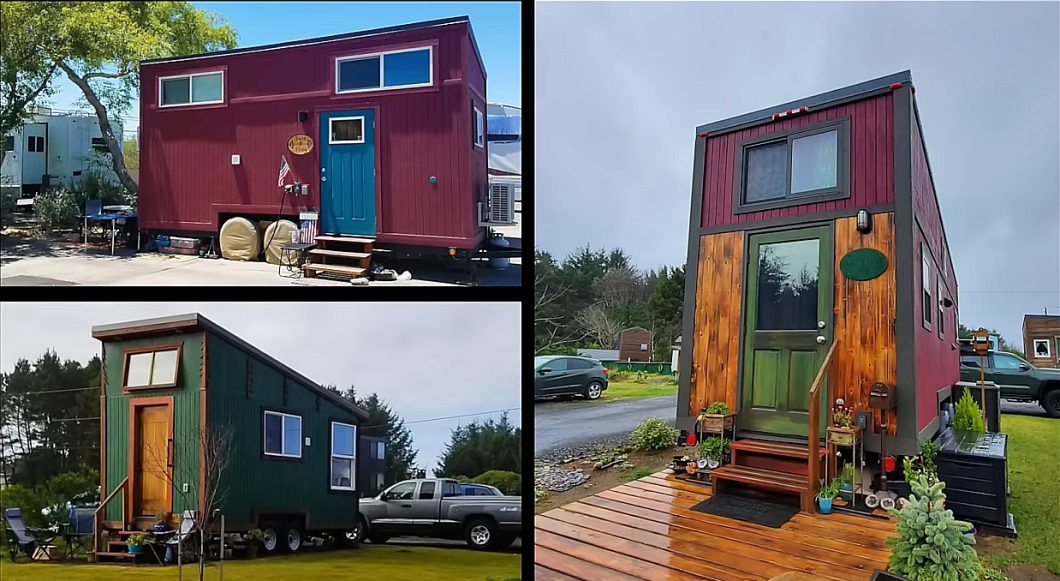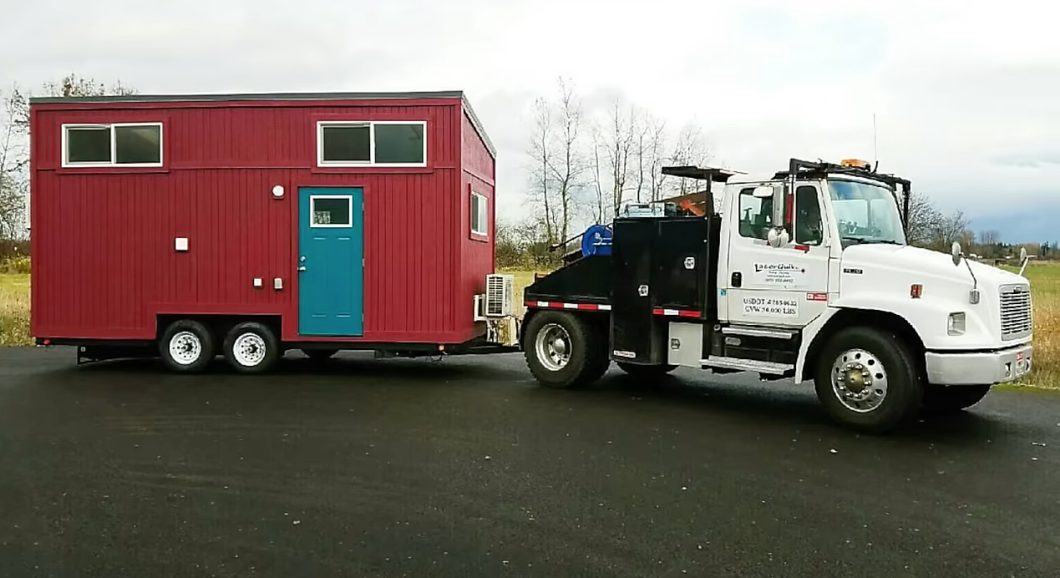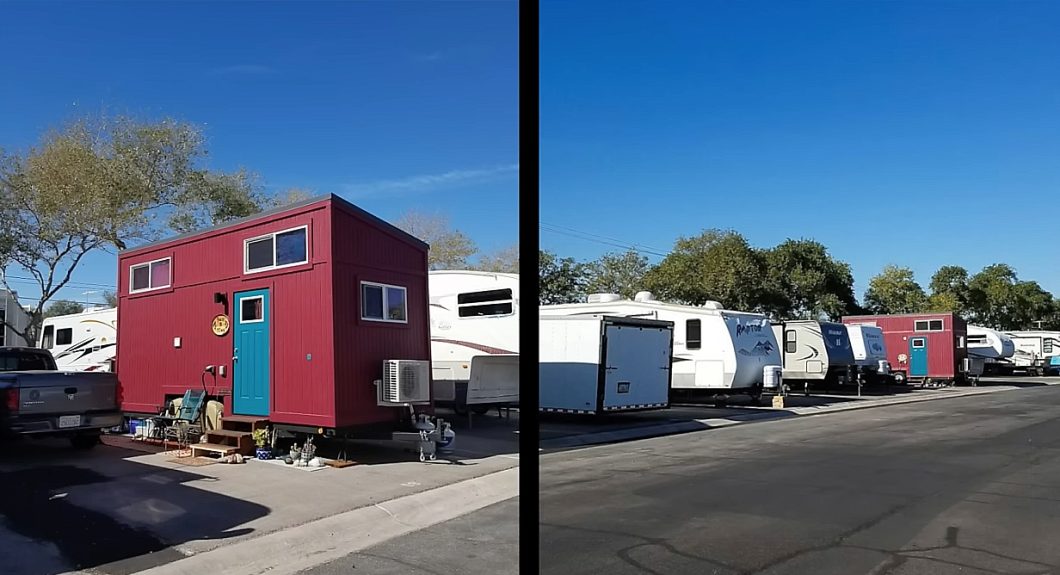Over the past seven years, Brenda has lived in three tiny homes in various climates and locations. This experience, including a tragic towing misadventure, has given her much wisdom. Because of this, she’s passionate about helping others interested in tiny living learn from her experience.
In November 2018, Brenda’s original 20-foot tiny house on wheels crashed on the interstate in Northern California. She had planned to take her home to the builder’s shop for a special project. During transit by a professional hauler, it flipped over on its side. Tragically, it was totaled.
Fortunately, the kind owner of the Tiny Tranquility community on the Oregon Coast allowed her to rent an 18-foot tiny house vacation rental for nine months at an affordable rate. She worked with Tiny Smart House to design a new tiny home during that time.
Ultimately, Brenda customized a Pacific Northwest Mountaineer model. She chose a 24-foot model, giving her four more feet of space. This allowed her to add a downstairs home office with a closet, which can also be used as a second bedroom. Brenda and her builder also planned to recycle and reuse as many materials and belongings as possible from the wreckage of her original tiny home.
Tour Brenda’s Just B Tiny 2.0!
Brenda’s Tiny House Design Advice
Brenda’s number one tip when you go into designing your tiny house is to make two lists. One of what you want or think you need, and one to track your daily routine. So, when you wake up, you write down exactly what you do. So when you wake up, what’s the first thing you will do? Are you going to lean over and grab your cup of water? Are you gonna go to your bathroom to brush your teeth? Then, do you plan to make coffee or tea? This may seem silly, but you might miss something essential in your design if you’re not conscious about what you use daily.
Go back to prioritize your daily needs and your other desires. Next, take that list to your builder. Alternatively, if you’re doing your designing and building your own tiny house, use your lists to formulate where you need things
placed in your tiny and ensure that you get everything important. Use this online 3D Tiny House Designer to try out your ideas!
Brenda’s Tiny House Transport Advice
Brenda is happy to report that everything turned out just fine after her tiny house crash. She got lucky in many ways but was also very resourceful when contacting her network for help. That said, Brenda has crucial advice for planning a safe tiny house relocation.
“I’ve had like five different truckers. I’ve had good experiences, and I’ve had very bad experiences. One of them may be the reason my tiny crashed,” Brenda, @justbtiny
When you move your tiny house on wheels, it’s very important to research transportation companies and individual truckers. Check online reviews and ask for references in tiny house online forums, like Facebook groups. Also, make sure they are properly licensed and insured.
Everybody needs insurance if they’re going to have a tiny home. Importantly, you need to seek out coverage specifically for transportation. Brenda’s dwelling was covered, but whatever happened on the road was not. So ensure you are fully covered, including the structure and your belongings, when you get tiny house insurance. Don’t underestimate what you own!
Brenda’s Desert & Coastal Climate Experience
With her first tiny house, Brenda initially lived in Las Vegas. She found it to be a brutally hot desert environment, especially being parked on asphalt in an RV park. The hottest temperature she experienced was a whopping 116 degrees. Brenda quickly learned the importance of exterior materials, quality insulation, and efficient cooling.
For those interested in living in the Southwest, Brenda recommends carefully choosing exterior materials for your tiny house that can withstand extreme heat and sun exposure. Her home on wheels featured painted T-111 plywood, which held up exceptionally well with no color fading. However, her Just B Tiny stained wooden sign cracked in half after months of intense dry weather and UV rays in Vegas.
Brenda used a Fujitsu mini-split to cool her tiny house. In concert with high-quality residential insulation, her home’s interior stayed perfectly cool. But it did run all the time. Her highest electric bill was about $35 at 14.5 cents per kilowatt. In comparison to her traditional RV neighbors, this was ridiculously low. Their electric bill was around two hundred dollars monthly to cool less than 300 square feet.
Since moving to the Oregon coast, Brenda has encountered new challenges. She lives in the area with the highest salt concentration in the US, which causes significant wear and tear on homes, regardless of size. Brenda noticed that combatting rust on tiny house trailers is a real challenge in her tiny home community. “Salt just eradicates metal here,” she noted. Brenda has had to scrape off rust a couple of times over the last few years.
Another example of the impact of salt can be seen on Brenda’s cedar siding accent and deck. Her build used the Shoshiguban technique, which is supposed to preserve the wood, making it more durable. On top of that, she had two coats of sealant. By spring, signs of sealer remained.
She also noticed that her neighbor’s cedar siding changed color pretty quickly. It’s not bad if you like the rustic look, but consider annual re-sealing to help protect it. Brenda generally encourages considering the climate when deciding on a siding material for your tiny home.
Follow her tiny house life here, including her recent move to the other side of Oregon!





